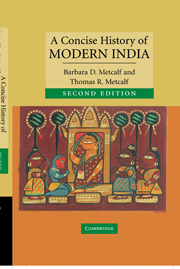Book contents
- Frontmatter
- Contents
- List of illustrations
- Preface to the second edition
- Preface to the first edition
- Glossary
- Chronology
- 1 Sultans, Mughals, and pre-colonial Indian society
- 2 Mughal twilight: the emergence of regional states and the East India Company
- 3 The East India Company Raj, 1772–1850
- 4 Revolt, the modern state, and colonized subjects, 1848–1885
- 5 Civil society, colonial constraints, 1885–1919
- 6 The crisis of the colonial order, 1919–1939
- 7 The 1940s: triumph and tragedy
- 8 Congress Raj: democracy and development, 1950–1989
- 9 Democratic India in the nineties: coalitions, class, community, consumers, and conflict
- Epilogue: a new century begins
- Biographical notes
- Bibliographic essay
- Index
- CAMBRIDGE CONCISE HISTORIES
Epilogue: a new century begins
Published online by Cambridge University Press: 05 June 2012
- Frontmatter
- Contents
- List of illustrations
- Preface to the second edition
- Preface to the first edition
- Glossary
- Chronology
- 1 Sultans, Mughals, and pre-colonial Indian society
- 2 Mughal twilight: the emergence of regional states and the East India Company
- 3 The East India Company Raj, 1772–1850
- 4 Revolt, the modern state, and colonized subjects, 1848–1885
- 5 Civil society, colonial constraints, 1885–1919
- 6 The crisis of the colonial order, 1919–1939
- 7 The 1940s: triumph and tragedy
- 8 Congress Raj: democracy and development, 1950–1989
- 9 Democratic India in the nineties: coalitions, class, community, consumers, and conflict
- Epilogue: a new century begins
- Biographical notes
- Bibliographic essay
- Index
- CAMBRIDGE CONCISE HISTORIES
Summary
As the new century began, many Indians anticipated that the twenty-first century would see their country's emergence at long last as a prosperous land and a world power. The image of India's old rival China leaping ahead year by year engaged, perhaps even inspired, Indians in their own quest for a better life for all. Above all, the first years of the new century saw an acceleration in India's rate of growth. By 2005, a growth rate of 6.5 per cent earlier in the decade had increased to between 7 and 8 per cent. But hundreds of millions were still left behind. When the BJP government sought to capitalize on this economic growth, with a campaign for re-election waged under the slogan ‘India Shining’, it was decisively defeated by a reinvigorated Congress party. By the time of this election, in 2004, the record of the BJP had, moreover, become tarnished by the events in Gujarat in 2002, when a fire in a railway carriage that killed some sixty Hindu pilgrims precipitated a series of horrendous attacks targeting Muslims throughout the BJP-ruled state. Hindu nationalism was out of office in the mid-2000s, but the sentiments that fuelled it were far from extinguished.
At the heart of India's growth in the new century, as in the 1990s, was its high-technology industry. Initially little more than the outsourcing of ‘back room’ data processing, and the supply of telephone ‘tech support’ for overseas companies, the Indian information technology (IT) industry during the first years of the twenty-first century blossomed into a new role as a major player in the world economy.
- Type
- Chapter
- Information
- A Concise History of Modern India , pp. 296 - 304Publisher: Cambridge University PressPrint publication year: 2006



